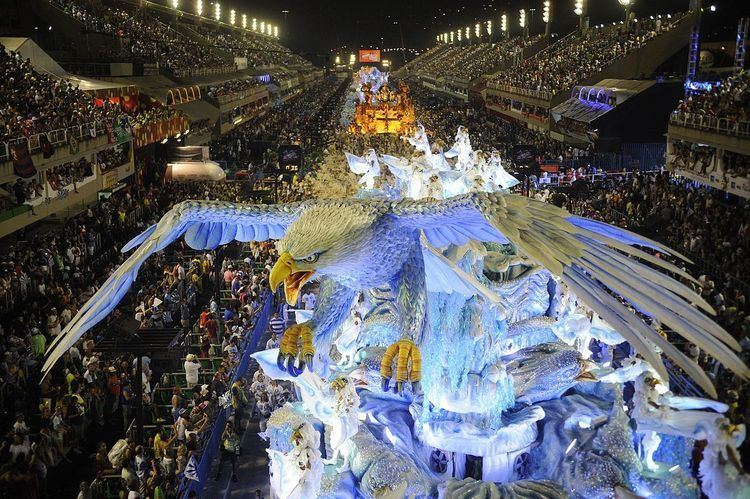Type Parade grounds Renovated 2012 | Groundbreaking 1983 Phone +55 21 2976-7310 Inaugurated 1984 | |
 | ||
Alternative names Passarela Professor Darcy RibeiroSambódromoSambadrome Named for Cândido José de Araújo Viana Other dimensions 570 metres (1,870 ft) in length, 12 metres (39 ft) in width Similar Brazilian Carnival, Copacabana - Rio de Janeiro, Sugarloaf Mountain, Maracanã, Christ the Redeemer | ||
Brazil carnival dancers in costume high definition views from above
The Sambadrome Marquês de Sapucaí is a purpose-built parade area built for the Rio Carnival in Rio de Janeiro, Brazil. The venue is also known as Passarela Professor Darcy Ribeiro or simply the Sambódromo in Portuguese or Sambadrome in English. It is located in the downtown area of Cidade Nova in Rio de Janeiro, and is the place where samba schools parade competitively each year during the Rio Carnival. The parades attract many thousands of Brazilians and foreign tourists each year, and the structure is also used as a multi-purpose performance venue. The structures of the Sambadrome were designed by the architect Oscar Niemeyer (1907-2012), and represent his first major work after the end of the Brazilian dictatorship of 1964-1985.
Contents
- Brazil carnival dancers in costume high definition views from above
- Fre h in rio de janeiro brazil episode 4 sambadrome marqu s de sapuca
- History
- The venue
- The Carnival parade events
- Upgrade for 2016 Summer Olympics and Paralympics
- References
Fre h in rio de janeiro brazil episode 4 sambadrome marqu s de sapuca
History
The Sambódromo was commissioned in 1983 and completed in 1984. It is one of two works designed by Oscar Niemeyer upon his return to Brazil after exile during the Brazilian dictatorship of 1964-1985. The democratic election of regional governors, notably in the state of Rio de Janeiro in 1982, signaled a return to civilian rule and renewed work for artists whose work was suppressed by the regime. Governor Leonel Brizola, a longtime Niemeyer associate, commissioned the Sambradrome to reflect socialismo moreno, or multicultural socialism. Niemeyer worked closely with vice-governor Darcy Ribeiro (1922-1997), a Brazilian anthropologist, on the location and building concept. The Sambadrome was not only to function as the centerpiece of the Rio Carnival, but also house a primary school with 115 classrooms underneath the bleachers of the structure. Niemeyers's Praça da Apoteose (Apotheosis Square), a 90 metres (300 ft) trilegged arch, became a noted symbol of the Rio Carnival.
The venue
The Sambódromo consists of a 700 metres (2,300 ft) stretch of Marquês de Sapucaí street converted into a permanent parade ground with bleachers (grandstands) built on either side for spectators. Its capacity is 90,000. The parade avenue is painted gray each year before Carnival. The complex includes an area located at the end of the parade route, the Praça da Apoteose (Apotheosis Square) near the Morro da Mineira, where the bleachers are set further back from the parade area, creating a square where revelers gather as they end their parade.
Outside the Carnival season, Apotheosis Square is occasionally used as a major concert venue in Rio de Janeiro. Artists who have performed in Apotheosis Square of the Sambadrome include Diante do Trono, Eric Clapton, Supertramp, the Black Eyed Peas, Pearl Jam, Elton John, Coldplay, Whitney Houston, Avril Lavigne, Britney Spears, Justin Bieber, Iron Maiden, Radiohead, Hillsong, Jonas Brothers, Nirvana, A-ha, Janet Jackson, Bon Jovi, David Bowie and the Rolling Stones.
In December, the samba schools begin holding technical rehearsals at the Sambadrome, leading up to Carnival.
The Carnival parade events
The official Carnival parades take place just before the start of Lent. They are held for four consecutive nights, during which schools parade one after another from 8pm until the morning. The Access Group A samba schools are hosted on Saturday, Special Group on Sunday and Monday and Group Rio de Janeiro 1 on Tuesday. The Special Group nights are by far the biggest attractions. The parades are televised nationally and are watched by large audiences.
Each samba school has a preset amount of time (75 minutes) to parade from one end of the Sambadrome to the other with all its thousands of dancers, its drum section, and a number of floats. Each school has its own unique qualities according to its own traditions. Schools are graded by a jury, and the competition is ferocious. On Ash Wednesday (quarta-feira de cinzas), grades are gathered and one school is declared the winner. The Parade of Champions is held the following Saturday featuring the five winning samba schools in the Special Group category and the A Series division winner, which joins the Special Group come the next year.
In 2008, ticket prices for normal bleacher, or Grandstands, seats in the Sambadrome on Special Group nights ranged between R$10 and R$500 (US$6.50 to US$312.50), with VIP Cabins, or Covered Boxes, seating (which includes open bar, buffet - dinner, dessert and more) and scalped tickets costing much more (starting from US$2,500.00, in the best locations).
Inflated prices to watch star samba schools exclude many Brazilians from attending. As a reaction to high levels of commercialization, Rio de Janeiro has experienced a resurgence in free block parties (Street Bands and Groups: Blocos) that take place in suburbs all over the city.
It is possible for a person who is not a member of any samba school to buy a costume and arrange for a spot as a dancer in one of the parade groups.
Upgrade for 2016 Summer Olympics and Paralympics
For the 2016 Summer Olympics, the venue hosted archery and the athletics marathon event, and for the 2016 Summer Paralympics, the venue will host archery.
In preparation for the Olympics, an old Brahma beer factory nearby was demolished and extra bleachers were built on the site, increasing spectator capacity by around 18,000 seats in accordance with Niemeyer's original vision of making the Sambadrome complex symmetrical. The reopening occurred on February 7, 2012. Mayor Eduardo Paes and architect Oscar Niemeyer attended the ceremony.
